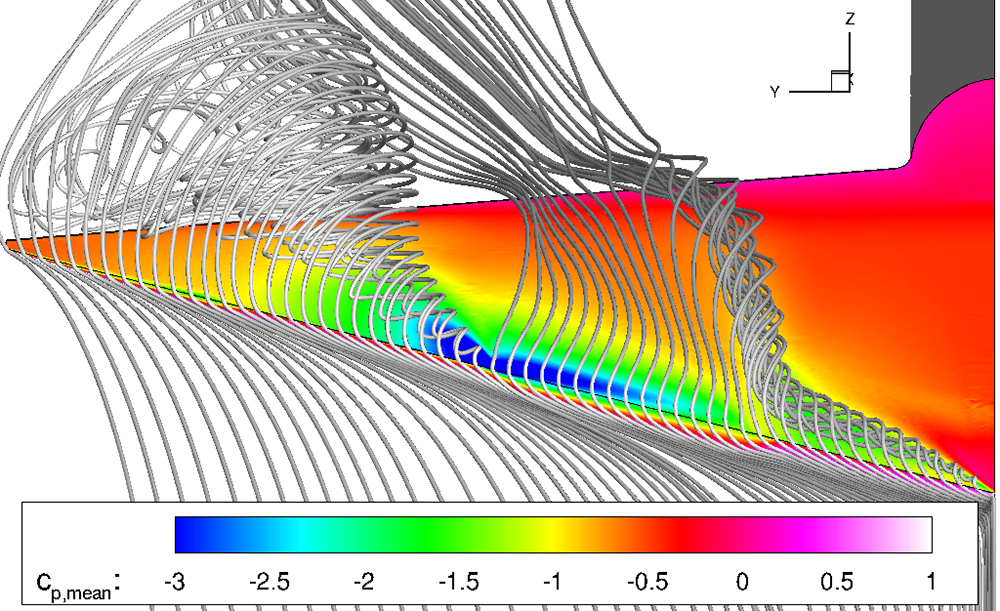ENGINEERING AND CFD
Aerodynamic Investigations of Vortex Dominated and Morphing Aircraft Configurations with Active and Passive Flow Control
Principal Investigator:
Christian Breitsamter
Affiliation:
AER/TU München (Germany)
Local Project ID:
pr86fi
HPC Platform used:
SuperMUC of LRZ
Date published:
Motivation
For delta and diamond wing configurations, the flow field is typically dominated by large scale vortex structures, which originate from the wing leading-edges. With increasing angle of attack, the flow structures grow in size and become more and more unsteady. The aerodynamic characteristics can change considerably, and large impacts on stability and control of the wing configurations are observed. Non-linear flow interactions occur over a wide range of analyzed scales. Following, a complex flow field is present. By use of active and passive flow control mechanisms such as dynamic blowing at the wing surface or rather varying leading-edge contours (morphing concepts and active leading-edge flaps), the vortex characteristics can be manipulated and controlled in some extent. Thereby, stability and control of such configurations can considerably be improved.
High-Performance Computing
For the detailed numerical analysis of vortex dominated wing configurations, time-resolved computations are required. Small time steps have to be applied in the computations, which often run up to one million time steps. In order to detect the vortex structures and the separated flow regions accurately, the flow problems are additionally to be solved on large computational grids. Overall, this results in high computational effort, which can only be coped with a high-performance computing system such as the SuperMUC at the Leibniz Supercomputing Centre (LRZ).
Results
The flow separation at the wing leading-edges, which forms the vortex structures, depends amongst others on the leading-edge shape. For sharp leading-edges, the flow separation is fixed geometrically, but for rounded leading-edge contours, other parameters such as the leading-edge radius have to be considered additionally. Within the present SuperMUC project, extensive analyses on leading-edge contour variations have been conducted. By example, Figure 1 introduces the resulting flow field including field streamlines for one considered leading-edge contour variation. For this wing configuration, vortex formation only takes place at sharp leading-edge segments, while attached flow is present with rounded leading-edge contours. This is mainly caused by a thick airfoil and an increased leading-edge radius. The wing configuration is equipped with sharp leading-edge contours in the most inboard wing section and in the outboard part of the midboard wing section. Different flow characteristics with separated vortex flow, attached flow and flow reversal are observed.

Figure 1: Flow field around a diamond wing configuration with leading-edge contour variation.
Copyright: AER, Technische Universität MünchenWith regard to stability and control of the wing configurations, not only the angle of attack, but also the sideslip angle is of great importance. Due to the swept wing planforms, the vortex structures develop differently, when a cross flow free stream condition is present. Figure 2 depicts the resulting flow field for a diamond wing configuration with deflected control surfaces. Moreover, the effectiveness of the control surfaces is highly threatened, when flow separation occurs. This is undesirable in any case, and following, the exact characteristics of the occurring vortex structures are very important to analyze.

Figure 2: Effect of cross flow free stream conditions on the vortex structures at high angle of attack.
Copyright: AER, Technische Universität MünchenFuture Work
Future work will focus in more detail on the computation of cases with dynamic blowing at the wing surfaces as shown in Figure 3 and leading-edge contour actuation to efficiently control the vortex structures. Both for these applications and the above introduced leading-edge contour variations, comprehensive experimental data is available. For this reason, validation aspects of the applied numerical methods will be intensified as well.

Figure 3: Effect of leading-edge blowing on the vortex structures at a delta wing configuration (left: blowing-off, right blowing-on).
Copyright: AER, Technische Universität MünchenAcknowledgements:
• Leibniz Supercomputing Centre (LRZ) for computing time on SuperMUC
• German Research Foundation (DFG) for financial support under contract no. BR 1511/6-1,-2
• German Aerospace Center (DLR) for providing the DLR TAU-Code
• ANSYS Inc. for providing the flow simulation software CFX and FLUENT
Research Team & Contact Information:
Dipl.-Ing. Andreas Hövelmann (Andreas.Hoevelmann@tum.de)
Dipl.-Ing. Jae-Hun You (Jaehun.You@aer.mw.tum.de)
Prof. Dr.-Ing. Christian Breitsamter (Christian.Breitsamter@aer.mw.tum.de)
Institute of Aerodynamics and Fluid Mechanics (AER) http://www.aer.mw.tum.de
Technische Universität München
Boltzmannstr. 15, D-85748 Garching bei München/Germany